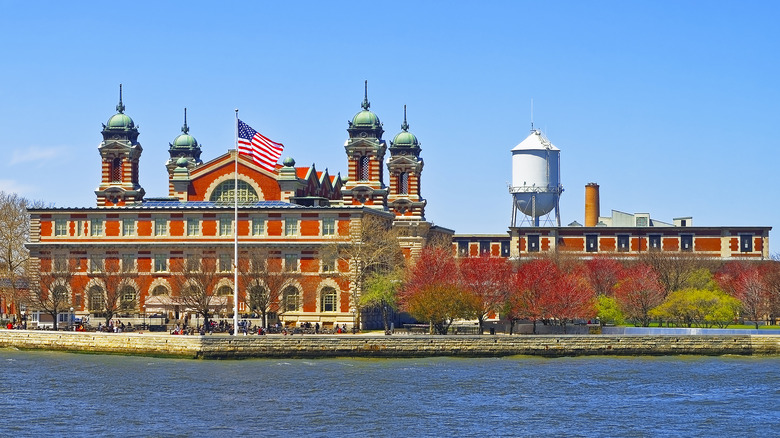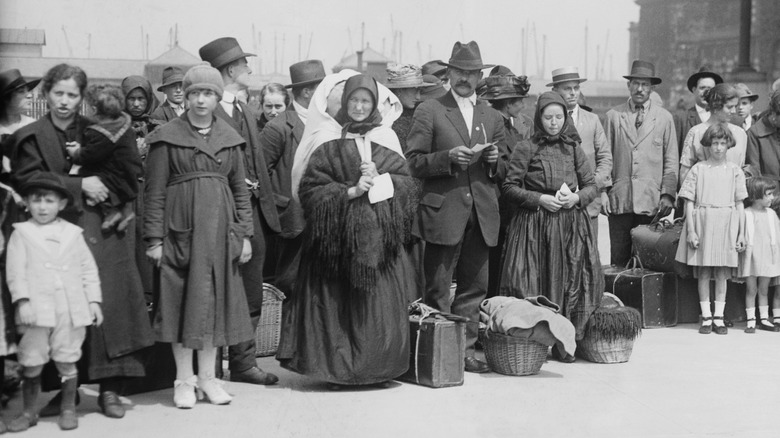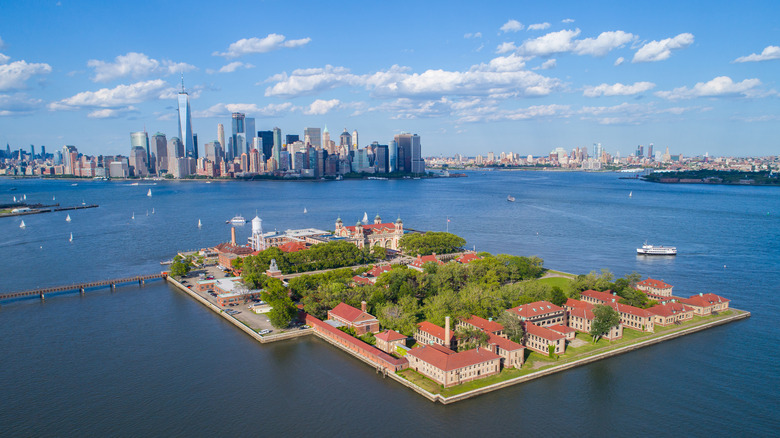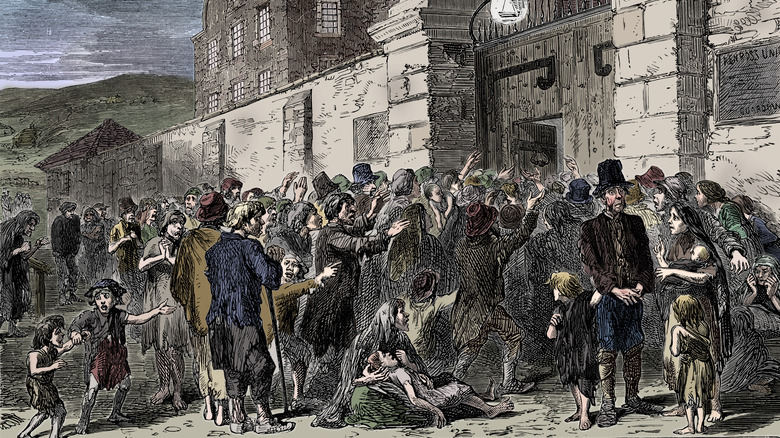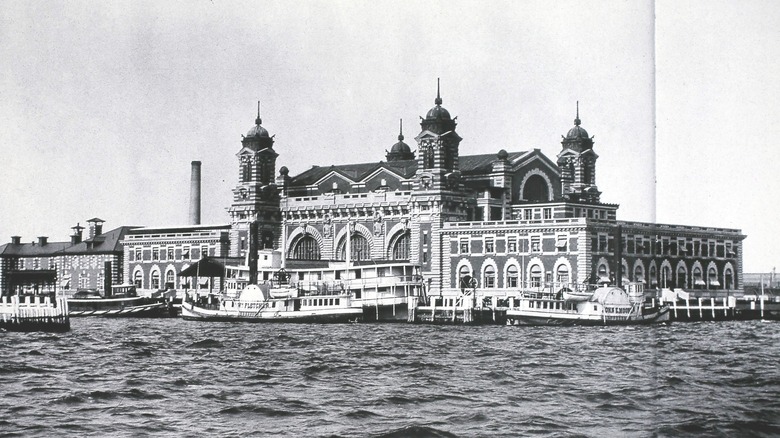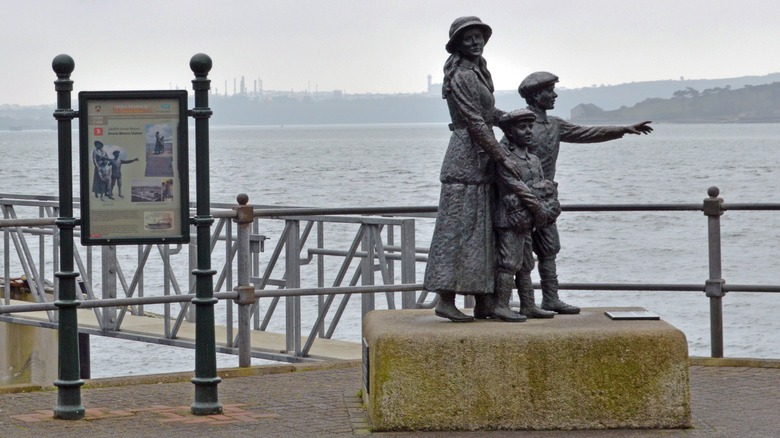Who Was The First Person To Immigrate Through Ellis Island?
At a time in American history when most of the immigration conversation is centered around the southern border, Ellis Island in New York City reminds its visitors of how long immigration has been a staple of life in the U.S. Ellis Island is on of the most well-known locations in the history of immigration to the United States. What makes it even more iconic is its proximity to the Statue of Liberty, which became a symbol of new life for those who approached the shores of New York.
However, immigration to the U.S. even predates the opening of Ellis Island. At first, Castle Garden in Manhattan was New York's immigration station, opening in 1855. During its nearly 40 years of operation, it welcomed the first major wave of immigration to the U.S. This wave consisted of eight million people mostly from Scandinavian countries, Ireland, Great Britain, and Germany. But by 1890, the real immigration boom had begun in the U.S. (via Statue of Liberty).
12 million immigrants passed through Ellis Island
According to History, immigrants arriving in the northeastern U.S. grew to include Italians and Jews. The driving forces of this new wave of immigration were poverty in Italy and oppressions of Jews throughout eastern Europe and Russia. Other migrants were Slavs from present-day Hungary, Czech Republic, Slovakia, and Poland. Even Turkish and Syrian migrants were heading west.
Ellis Island opened in 1892, and by the 1950s 12 million people had passed through. The hope for new opportunities that the image of the Statue of Liberty conveyed was not felt by all, however. The immigration process in the Registry Room was not always just a stamp on a document. Doctors checked each person for symptoms of cholera, tuberculosis, mental conditions, and contagious (if not deadly) eye infections. There was a hospital on site for those with any symptoms. Some migrants were detained at the island due to these health issues or for being deemed anarchists, stowaways, or members of unfavorable political parties (via PBS).
700 immigrants arrived on the first day that Ellis Island was open
The Statue of Liberty explains that first and second class passengers aboard ships arriving to the United States were not required to pass through Ellis Island for health and legal checks as third class passengers were. Their inspections were conducted before arrival. Third class passengers were also stuck in unsanitary, crowded areas of the ship. Even third class passengers on the Titanic (which also carried immigrants) were housed in the lowest levels of the ship.
On New Year's Day 1892, three boats arrived in New York City with a total of 700 immigrants. The first boat, the S.S. Nevada, arrived after sailing for 12 days. On board was Annie Moore and her younger brothers, Anthony and Phillip, who had sailed from southern Ireland. After braving the rough third class conditions, Annie was the first to step off at only 17 years old. Their parents had already arrived in New York a few years prior. Annie went through the doctor's health checks and an interview. Before leaving the island on a boat to Manhattan, officials gave her $10 (via Irish Central).
Annie Moore was one of thousands of Irish immigrants
Was Annie Moore just the person who happened to be at the front of the line? Or was there a reason that she was there? Though she really was the first immigrant to come through Ellis Island, History speculates that New York newspapers chose her to be the face of their immigration stories. The majority of people on the S.S. Nevada were not Irish, but Irish people had gained respectful positions in the eyes of Americans by the time that Annie arrived. Newspapers also did some embellishing to make more popular stories. They wrote that New Year's Day was Annie's birthday as well. A "rosy-cheeked" Irish teenager who spoke English and whose birthday was on the day that she arrived to America all made for a good story.
Newspapers covering Annie's arrival reflects a change in the hearts and minds of Americans with regard to the Irish. Though the Irish already made up a large portion of immigrants in the United States, the devastating Potato Famine of the 1840s drove even more Irish people out of Ireland. The Irish arrived poor and worked for low wages, which attached to them a negative stigma. Religious tensions between their new Protestant American neighbors frequently boiled as well. It was not until the end of the 1800s, as Irish people gained political power, that contempt for them began to wane (via LOC).
Ellis Island operated for 62 years
Annie Moore remained in New York City for the rest of her life. Irish Central recalls that she lived near 99 Cherry St, which is located between the Brooklyn Bridge and Manhattan Bridge. Her husband, German-American Joseph Augustus Schayer, worked at the Fulton Fish Market. A Fulton Fish Market still exists in Manhattan today, just around the corner from the New York Stock Exchange. The two had 11 children according to Find A Grave. Annie passed away from heart failure in 1924 and was largely forgotten by history until restoration projects on Ellis Island began around 60 years later.
Ellis Island operated for 62 years by the time that it closed in 1954. During those 62 years, its purpose expanded beyond immigration services. The U.S. Department of Justice arrested suspected communists and detained them at Ellis Island during World War I and prisoners of war were held there during World War II. Ellis Island had room for these people because of attitudes against immigration from the American people and from politicians who began limiting the numbers of immigrants allowed into the U.S. in 1921 (via PBS).
There is a statue of Annie Moore in Cobh, Ireland
There is now a statue of Annie Moore and her brothers in Cobh, Ireland to acknowledge the struggles of British oppression and famine that the Irish faced, which prompted them to seek new life elsewhere in the 19th century. Another statue is located at the Ellis Island Museum (via Guide Ireland). This museum takes visitors through the entire history of immigration in the United States and is located in the original Ellis Island building. What was once the Registry Room and dorms for detained people have both been made into exhibits as well.
Just as researchers were able to keep record of Annie Moore's arrival to Ellis Island, records of the millions of people who passed through the island still exist. The Passenger Search feature on the Statue of Liberty Website allows people to learn more about their own family heritage. Given that around 40 percent of the present-day population of the U.S. can trace its ancestry back to someone recorded by Ellis Island, its relevance to U.S. history won't be forgotten any time soon.
